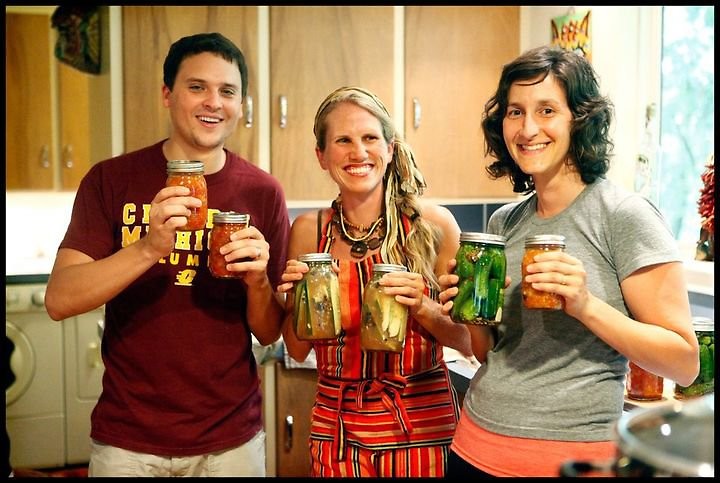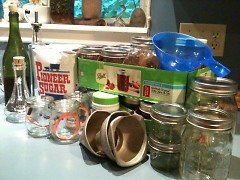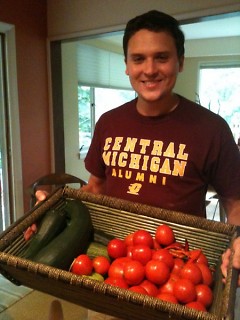The canning bug is sweeping across America! The last time canning was this popular was during WWII as women canned harvests from their Victory Gardens to win the war.
Today, people across the country are re-finding the joy and benefits in canning local produce during the harvest -- it's fresher, the food has "roots" in local soil, and it instills a sense of pride as the finished jars go, "pop, pop, pop" as they cool on the counter and colorfully line the pantry shelves.
Join the movement! Open your home, gathering friends and family with produce and supplies (and snacks!). Come together to share the work, put some food into jars, and develop kinship in the kitchen. Start a Canvolution.
First things first -- pick a day and find your friends.
Never canned a jar of food in your life? Or are you a seasoned canner ready to move beyond the basics? It doesn't matter! Invite people who want to can into the kitchen!
If you are a beginner and you feel you need some guidance, think about inviting over a few friends that might already know a bit about canning-- jam makers, pickle makers, lacto-fermenters, booze infusers-- you know the lot. Those seasoned sorts can help with the technical aspect of canning and can make those new to the preserving process feel comfortable in learning new skills.
Alternately, if you've got friends and none of them have ever canned anything, don't fret. Pick one recipe to learn together as a shared experience.
Recipes and ideas- Making it fresh.
In deciding what to can ask -- What is in season at the Farmer's Market? What is ready to harvest in the garden? Seasonality and getting produce picked in its most vibrant state is one of the best parts about the canning/preserving process.
If you are not fully familiar with the growing season in your area, take a look at a seasonal harvest calendar to get an idea of what is ready for harvesting when.
Also, think about the dishes you like to make on a regular basis and what you may want to have on hand through the winter. Prefer canned peaches, string beans, or stewed tomatoes? Want to have a selection of condiments on hand like syrups or mustards? Want to make jams that can be used for toast or strudels?
For the canning party, these questions can be posed in advance to the group as part of the planning process. Social network sites like Facebook (set up a private group page) are easy tools to facilitate and share recipe ideas.
Ready to branch out with new canning ideas?
Popular online food culture groups like Food in Jars, Canning Across America, Nourished Kitchen and Punk Domestics offer an amalgam of recipes for preserving the harvest, covering everything from infused liqueurs to lacto-fermentation techniques. No limits to the imagination once canning basics are nailed down.
Got family recipes?
This is an AWESOME time to resurrect and discover a part of your own history. Bring out the old recipe books for Grandma's pickles or jam. If Grandma is still living, give her a call and ask her about her canning memories.
And whatever recipes are decided on by the group, it's great to have copies on hand for the canning party to use as a reference and also for others to keep for their own recipe box. The sharing of recipes in and of itself is one of the great takeaways from a canning party.
A well stocked pantry.
Being well prepared the day of the event with supplies, produce, herbs, oils, vinegars, pans, and so on will make the day run smoothly and enjoyable for everyone. Items needed can be arranged by either the host of the party or the list can be delegated among the group. Cost for supplies, including produce, should be split equitably either in cash or with a fair trade. It's recommended to keep a general record for reimbursement and for planning future canning events.
Party aside, it's in every canner's interest to keep costs low in setting up (and replenishing) their canning kit. Procuring second-hand equipment like canners, funnels, ladles, measuring cups and jars (new lids are required with each new batch of preserves) whenever possible is awesome.
Grandma, resale, garage sales and estate sales are great ways to help build out your canning supplies. So in assembling your party, perhaps there is someone with a secret garage sale knack willing to help the group save some money. (See below for a basic list of supplies you'll need for your party and for canning adventures).
Food safety.
Before any canning begins, make sure everyone involved has basic working knowledge of food safety, handling and processing. Take some time (preferably before the canning party) to review food safety basics. The USDA offers a FREE online resource with a complete index of topics on canning and process at the National Center for Home Food Preservation. LOTS of good information, and highly recommended to be reviewed by everyone in advance of the canning day to ensure the kitchen is setup and the cooks are prepared for proper food handling and processing for maximum food safety.
Not all work -- make the day social.
While all this planning may seem like a bit much, remember - The canning party can be as simple or as grandiose as you want it to be, depending on where YOU are at in your kitchen learning and where you want to go with your group canning adventure.
And be sure that someone(s) helps organize snacks and drinks for munching and sipping. Take time to laugh and enjoy each other's company. Leaving at the end of the day with a share of the garden's bounty canned in hand is nice, but the memory of friends in the kitchen together is most lasting than the food itself.
Happy Canning and "Cheers" to starting a Canvolution!
~~~~~~~~~~~~~~~~~~~~~~~~~~~~~~~~~~~~~~~~~~~~~~~~~~~
A Well-Stocked Canning Pantry. Be prepared!
- Produce, Meats (or whatever you fancy)
- Jars, bottles of all sizes per the recipes you'll be making (remember to make enough so everyone leaves with a few jars)
- New lids
- Canners, large pans, small pans, tea kettle for boiling water
- Jar tongs, hot pads, ladles, funnels, measuring cups and spoons
- Pens, paper pencil to record the recipes, amounts especially if the canning party is experimenting with new recipes and test batches
- Preservation materials: Vinegars, olive oil, honey, sugar, sea salt, kosher salt, liquor
- Herbs: Dill, coriander, black pepper, cinnamon, nutmeg, allspice, cumin, garlic, onion, salts - list not exhaustive, and premade mixes are fine
- Plenty of hand towels, dishrags, and aprons for guests (food safety = work clean)
The Rapidian, a program of the 501(c)3 nonprofit Community Media Center, relies on the community’s support to help cover the cost of training reporters and publishing content.
We need your help.
If each of our readers and content creators who values this community platform help support its creation and maintenance, The Rapidian can continue to educate and facilitate a conversation around issues for years to come.
Please support The Rapidian and make a contribution today.




Comments
Would love to hear from others who want to give this a shot!